Kichisaburō Nomura
Kichisaburō Nomura (野村 吉三郎, Nomura Kichisaburō, December 16, 1877 – May 8, 1964) was an admiral in the Imperial Japanese Navy and was the ambassador to the United States at the time of the attack on Pearl Harbor.
Kichisaburō Nomura | |
|---|---|
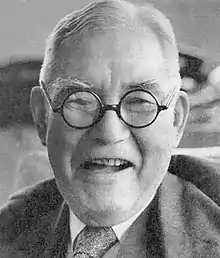 | |
| Native name | 野村 吉三郎 |
| Born | December 16, 1877 Wakayama, Wakayama, Japan |
| Died | May 8, 1964 (aged 86)[1] Shinjuku, Tokyo, Japan |
| Allegiance | |
| Service/ | |
| Years of service | 1898–1937 |
| Rank | |
| Commands held |
|
| Awards | Order of the Rising Sun |
| Other work |
|
| Signature | |
Early life and career
Nomura was born in Wakayama city, Wakayama Prefecture. He graduated from the 26th class of the Imperial Japanese Naval Academy in 1898, with a ranking of 2nd out of a class of 57 cadets. As a midshipman, he served on the corvette Hiei and battleship Yashima. He was promoted to ensign on January 12, 1900, and to sub-lieutenant on October 1, 1901. As a crewman, he made a voyage to the United States on the battleship Mikasa from 1901 to 1902.
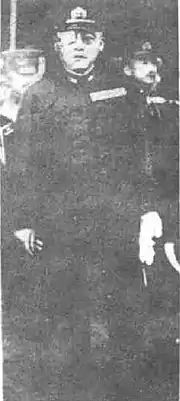
Promoted to lieutenant on September 26, 1903, he served on a large number of ships, including the gunboat Maya, corvette Kongō, and cruiser Tokiwa. He served as chief navigator on the cruiser Saien (1904) and cruiser Takachiho during the Russo-Japanese War. After the war, he was chief navigator on the cruisers Hashidate and Chitose. In March 1908, he was sent as naval attaché to Austria. He was promoted to lieutenant commander on September 25, 1908, and became naval attaché to Germany in 1910. He returned to Japan in May 1911 and became executive officer on the cruiser Otowa in September 1911. In June 1912, he was assigned a number of staff roles and was promoted to commander on December 1, 1913. During World War I, from 11 December 1914 until 1 June 1918, Nomura was naval attaché to the United States. While in the United States, he was promoted to captain on April 1, 1917.
On Nomura's return to Japan, he received his first command, the cruiser Yakumo. However, only a month later, he was reassigned to the Imperial Japanese Navy General Staff, joining Japan's delegation to the Versailles Peace Treaty Conference. Following the conclusion of negotiations, he returned to Washington, DC, to participate in the Washington Naval Conference of 1921–1922.
Admiral
On June 1, 1922, Nomura was promoted to rear admiral. He served as chief of the 3rd section of the Navy General Staff, followed by Commander of the 1st Expeditionary Fleet, Director of the Education Bureau, and Vice Chief of the Navy General Staff. He was promoted to vice admiral on December 1, 1926. On June 11, 1930, Nomura became Commander in Chief of the Kure Naval District. He was Commander in Chief of the Yokosuka Naval District in December 1930.
During the First Shanghai Incident in 1932, he was appointed as commander of the Japanese forces (army and navy) fighting in Shanghai. However, he was replaced by Kenkichi Ueda when the Japanese forces did not manage to win. Finally, Yoshinori Shirakawa was the Japanese commander appointed who won the battle in Shanghai. All three men were injured in April that year when Yun Bong-gil detonated a bomb during a celebration of Emperor Hirohito's birthday at Shanghai's Hongkou Park.[2] Nomura was blinded in one eye during the incident.[3]
Nomura was promoted to full admiral on March 1, 1933. From 1933 to 1937, Nomura served as Naval Councilor on the Supreme War Council, and retired from active service in 1937.
Diplomat
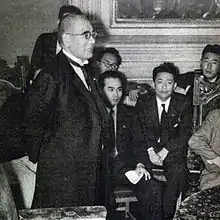
After his retirement, Nomura was principal of the Gakushūin Peer's school from 1937 to 1939. He was appointed Foreign Minister of Japan from 1939 to 1940 in the cabinet of Nobuyuki Abe. On November 27, 1940, Nomura was sent as ambassador to the United States, replacing Kensuke Horinouchi, who had served since March 1939. Throughout much of 1941, Nomura negotiated with United States Secretary of State Cordell Hull in an attempt to prevent war from breaking out between Japan and the United States. Nomura and Hull attempted to resolve issues including the Japanese conflict with China, the Japanese occupation of French Indochina, and the US oil embargo against Japan. Nomura's repeated pleas to his superiors to offer the Americans meaningful concessions were rejected by his own government.[4] On November 15, 1941, Nomura was joined by a "special envoy" to Washington, Saburō Kurusu.[5]
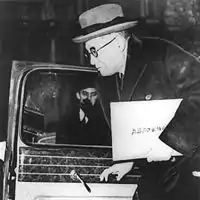
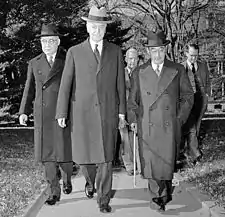
After World War II, Nomura denied that he knew that the attack would take place.[6] Nomura and Kurusu had to decode the radioed message personally of Japan's breaking off the negotiations with the United States, which, given the circumstances, practically meant war since it had been sent from Japan on Monday, December 8, and it was received while the embassy's technical support staff were still on their Sunday holiday. Nomura stated that to be why he had been unable to deliver the message until after the actual attack had taken place.[7] In his memoirs, Hull credited Nomura as having been sincere in trying to prevent war between Japan and the United States.[8]
Later life
On August 20, 1942, Nomura returned to Japan. He continued to serve in an unofficial capacity as an advisor to the government through World War II, and he was appointed to the Privy Council in May 1945.
After the war, Nomura started a new career. He was hired by Konosuke Matsushita to work in his company as a general manager and was sent to manage Victor Company of Japan, which was owned by Matsushita. He was then invited by Prime Minister Shigeru Yoshida to serve as a member of a committee studying rearmament of Japan.
In 1954, Nomura ran for the House of Councillors (upper house) and was elected by a landslide. In the late 1950 he was considered to be a strong candidate to head the Defense Agency by two prime ministers, Ichirō Hatoyama and Nobusuke Kishi, however he declined both offers and expressed his belief in civilian control of armed forces. Nomura had been a civilian for nearly two decades by that time, but was still regarded by many as a retired admiral of the old Imperial Japanese Navy.
Nomura was re-elected to the upper house in 1960 and died in office in 1964.
Honors
From the corresponding article in the Japanese Wikipedia
- Grand Cordon of the Order of the Rising Sun – 7 February 1934
- Order of the Golden Kite, Second Class – 29 April 1934
- Grand Cordon of the Order of the Sacred Treasure – 13 July 1940
- Grand Cordon of the Order of the Paulownia Flowers – 8 May 1964 (posthumous)
- Navy Distinguished Service Medal – 1918 (United States)
Notes
- "Nomura, Kichisaburo". Nishida. Retrieved February 25, 2020.
- Morris-Suzuki et al. 2013, p. 169.
- Polmar & Allen 2012, p. 584.
- Herbert P. Bix, Hirohito and the Making of Modern Japan, p. 421
- Prange 1981, p. 358.
- Victor 2007.
- Stinnett 2000.
- Hull, Cordell (1948). The Memoirs of Cordell Hull, Part II. New York: Macmillan Company. p. 987.
References
Books
- Morris-Suzuki, Tessa; Low, Morris; Petrov, Leonid; Tsu, Timothy Y. (2013). East Asia Beyond the History Wars: Confronting the Ghosts of Violence. Routledge. ISBN 9781136192265.
- Polmar, Norman; Allen, Thomas B. (2012). World War II: the Encyclopedia of the War Years, 1941-1945. Courier Corporation. ISBN 9780486479620.
- Prange, Gordon W. (1981). At Dawn We Slept: The Untold Story of Pearl Harbor. New York: McGraw-Hill. ISBN 0-07-050669-8.
- Stinnett, Robert (2000). Day Of Deceit: The Truth About FDR and Pearl Harbor. Free Press (Touchstone edition). ISBN 0-7432-0129-9.
- Victor, George (2007). The Pearl Harbor Myth: Rethinking the Unthinkable. Potomac Books. ISBN 1-59797-042-5.
Further reading
- Peter, Mauch (2011). Sailor Diplomat: Nomura Kichisaburo and the Japanese-American War. Harvard University Asian Center. ISBN 978-0-674-05599-5.
External links
| Wikimedia Commons has media related to Kichisaburō Nomura. |